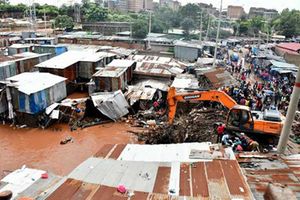Say No to white elephants

When Xavier Nyaga decided to actualise his long-cherished dream of building himself a house late last year, he knew it was going to be a walk in the dark, despite the thrill that would finally come with owning a home.
“Being a first-timer, everything was a risk. I didn’t know it involved so many processes and procedures. When I started, even terms like “skirting” would leave me at sea. Now, I am enjoying every bit of the process,” an excited Nyaga says.
His will be a four-bedroom maisonette on Thika Road. On the ground floor will be a garage, the living room/lounge, the dining area, the kitchen, the toilet/ bathroom and the visitors’ bedroom. Upstairs will have an en suite master bedroom, two other bedrooms, a family/study room, a bathroom and a toilet.
The walls of the house, which is being built on the 80m by 40m (slightly less than an eighth of an acre) plot, are already up and the team he has hired is now preparing to put up reinforcement columns before doing the slab for the ground floor.
For the few months he has been at it, Mr Nyaga has realised that “risk” is a term that will continue to be part of the process until he completes the house.
Luckily for him, there haven’t been any serious unforeseen setbacks as to put the project on hold or even abandon it altogether. He attributes this to getting things right from the beginning.
“Before I even bought the plot, I consulted widely. I talked to people who had built before; I also talked to a trustworthy friend who has also built a house in the same locality,” he notes.
He projects he will have spent between Sh1.4m and Sh2m by the time the house is completed. This is exclusive of the nearly Sh1.2m he spent on buying the parcel of land and related transactions and the transfer process. Land alone cost him Sh950,000. He has so far spent Sh600,000 on the main structure and labour.
So far, he says the labour component that has sprung him a surprise. When they started by digging up the foundation, daily labour charges had been oscillating between Sh7,000 and Sh9,000. But this rose up to Sh12,000 the day they were cementing the foundation.
“I am happy I am still within my projection,” he says. But he has learnt one fundamental rule that any prospective self-builder should always consider non-negotiable: Never draw a line at the bottom of your budget until you have included an appropriate contingency sum.
If you don’t do so, then you will be tempting fate and your dream for a home could end in tears. “I have learnt never to say, ‘I can’t spend a shilling beyond what I budgeted for’ as long as there is justification for it,” Mr Nyaga says.
As a self-builder or a Do-It-Yourself, you can cut the risk factor if you learn to expect the unexpected during the building process. In a world where risk cannot be pinned down with certainty, self-builders who abandon the contingency life belt, sometimes find themselves mired in an inescapably modern swamp of events that may eventually stall the project.
This does not need to be the case if the self-builder acknowledges that managing risk is a core part of the self-build process, rather than something to be tidied into a corner.
According to Haron Nyakundi, chairman of the Quantity Surveyors Chapter of the Architectural Association of Kenya, in the building process, there are usually lots and lots of unbudgeted items that usually emerge with every new stage.
It could be the land you are building on or workers who do not perform their duties but still find ways of charging you for it. Sometimes, it could be the suppliers failing to deliver the quality and quantity of materials you ordered.
You may have paid for 20 tons of sand only to be supplied with 15. You could buy under-gauge steels. You could also get incorrect concrete mixes. The building may not be the correct size or the rooms may not be sized correctly or the sitting of the building may not be correct to take care of the sun and rain.
“I have also seen buildings where storey heights are not correct – the heights are either too low or too high,” Mr Nyakundi says.
He says in the building process, there are usually hidden costs – sometimes arising from the finer details of the project – that cannot be seen or factored in at the beginning of the project, but that can end up spoiling the party, thus the need to put in place a contingency measure.
“We normally advise self-builders to put aside a contingency sum for unforeseeable issues in the project. Every aspect or stage of the building process can swing a surprise on you. There could be delays or price changes that you least expected. You must have a contingency sum in place to mitigate such unpredictable occurrences,” Mr Nyakundi says.
Writing in The Independent newspaper of London, Will Anderson says that the self-builder or Do-It-Yourself should think of a contingency as a range. The bottom end, he says, may represent the level of debt you would be happy with and may be all that appears on your budget.
On the other hand, the higher end, he notes, is your private estimate of how far you could go if push really came to shove. Crucially, he stresses, this figure should never appear on your initial budget “or else you will end up weeping into your cement-mixer”.
He says a self-builder should do all the hard work to minimise risks at the outset: “Nothing beats detailed specification, project planning, budgeting and cost control.”
This, according to Mr Nyakundi, means that the builder must consult widely and seek advice from those who have done it before as well as engaging qualified professionals at every stage.
“The place to start when you want to minimise risks is to consult... They will at least caution you about where they failed,” Mr Nyakundi says.
He adds that the builder must also engage the services of a knowledgeable contractor or a qualified foreman who has worked on successful building projects and understands procedures and standards.
Mr Nyaga bears him out: “I have come to realise that there is nothing better than talking to someone who has done it and has a house standing as proof. I consulted widely from people I trust and whom I knew had nothing to gain from me losing. I usually ask questions – and where necessary, twice. I also get “involved” so that I can learn as much as possible about the building process.”
Through consultation, he managed to get a foreman he says has “saved him from unnecessary heartaches”. “He was recommended to me by someone I trust so much. He built his house and recently a block of flats. He is a trustworthy man who negotiates with suppliers on my behalf and never inflates the price of anything to be bought. He knows where to get good materials at fair prices,” he says.
Before starting the project, he sat down with the foreman and asked him what was involved – the financial projections and the time frame. They then broke the process into three stages – foundation, courses and the slab.
This level of constant consultation and trust between him and the foreman, he says, has seen most of his initial fears dissipate and turned the experience from a “walk in the dark” into almost a “walk in the park”.
And it has left him yearning for more: “I may not a business person, but should I think of getting into business, it will definitely be real estate.”




